trailer Citroen DS5 RHD 2014 1.G Owner's Manual
[x] Cancel search | Manufacturer: CITROEN, Model Year: 2014, Model line: DS5 RHD, Model: Citroen DS5 RHD 2014 1.GPages: 400, PDF Size: 37.32 MB
Page 6 of 400
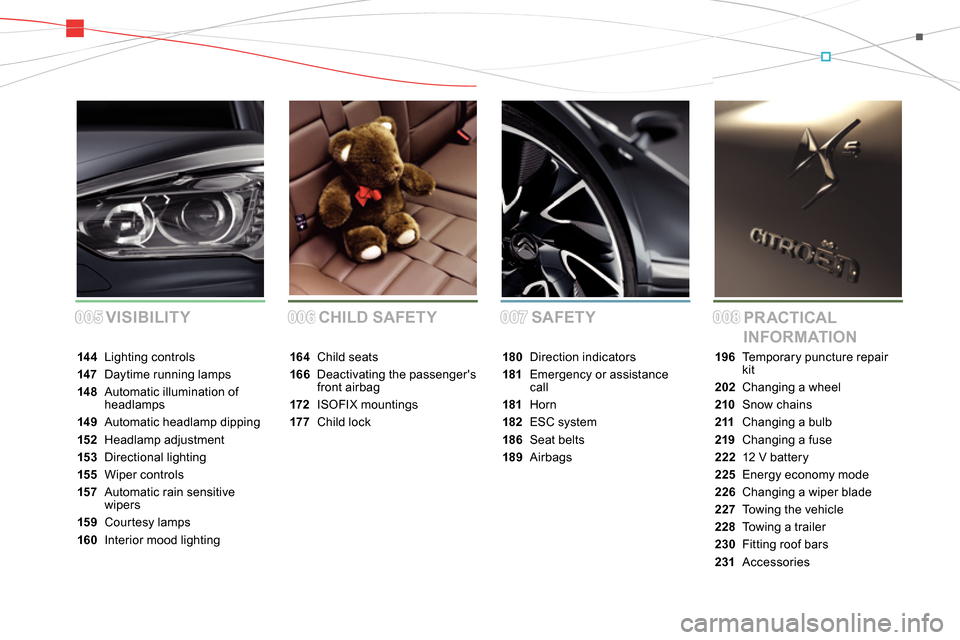
005005006006007007008008SAFETY
PR ACTICAL
INFORMATION CHILD SAFETY VISIBILITY
14 4 Lighting controls
147 Daytime running lamps
14 8 Automatic illumination of
headlamps
14 9 Automatic headlamp dipping
152 Headlamp adjustment
15 3 Directional lighting
155 Wiper controls
157 Automatic rain sensitive
wipers
15 9 Courtesy lamps
160 Interior mood lighting164 Child seats
166 Deactivating the passenger's
front airbag
172 ISOFIX mountings
17 7 Child lock180 Direction indicators
181 Emergency or assistance
call
181 Horn
182 ESC system
186 Seat belts
189 Airbags196 Temporary puncture repair
kit
202 Changing a wheel
210 Snow chains
211 Changing a bulb
219 Changing a fuse
222 12 V battery
225 Energy economy mode
226 Changing a wiper blade
227 Towing the vehicle
228 Towing a trailer
230 Fitting roof bars
231 Accessories
Page 23 of 400
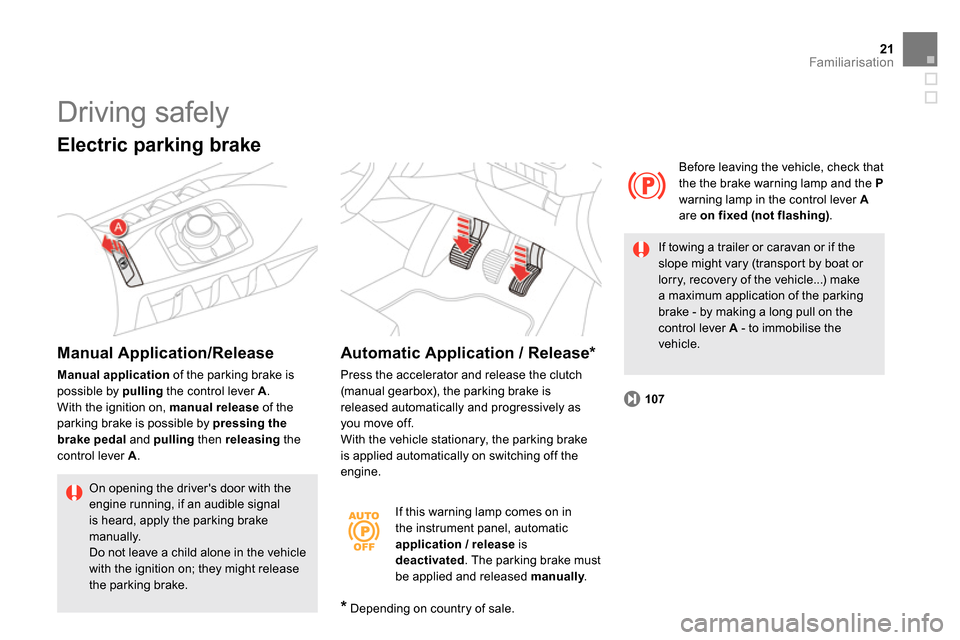
107
21Familiarisation
If this warning lamp comes on in
the instrument panel, automatic
application / release
is
deactivated
. The parking brake must
be applied and released manually
.
Before leaving the vehicle, check that
the the brake warning lamp and the P
warning lamp in the control lever A
are on fixed (not flashing)
.
If towing a trailer or caravan or if the
slope might vary (transport by boat or
lorry, recovery of the vehicle...) make
a maximum application of the parking
brake - by making a long pull on the
control lever A
- to immobilise the
vehicle.
*
Depending on country of sale.
Automatic Application / Release *
Press the accelerator and release the clutch
(manual gearbox), the parking brake is
released automatically and progressively as
you move off.
With the vehicle stationary, the parking brake
is applied automatically on switching off the
engine.
On opening the driver's door with the
engine running, if an audible signal
is heard, apply the parking brake
manually.
Do not leave a child alone in the vehicle
with the ignition on; they might release
the parking brake.
Manual Application/Release
Manual application
of the parking brake is
possible by pulling
the control lever A
.
With the ignition on, manual release
of the
parking brake is possible by pressing the
brake pedal
and pulling
then releasing
the
control lever A
.
Electric parking brake
Driving safely
Page 28 of 400
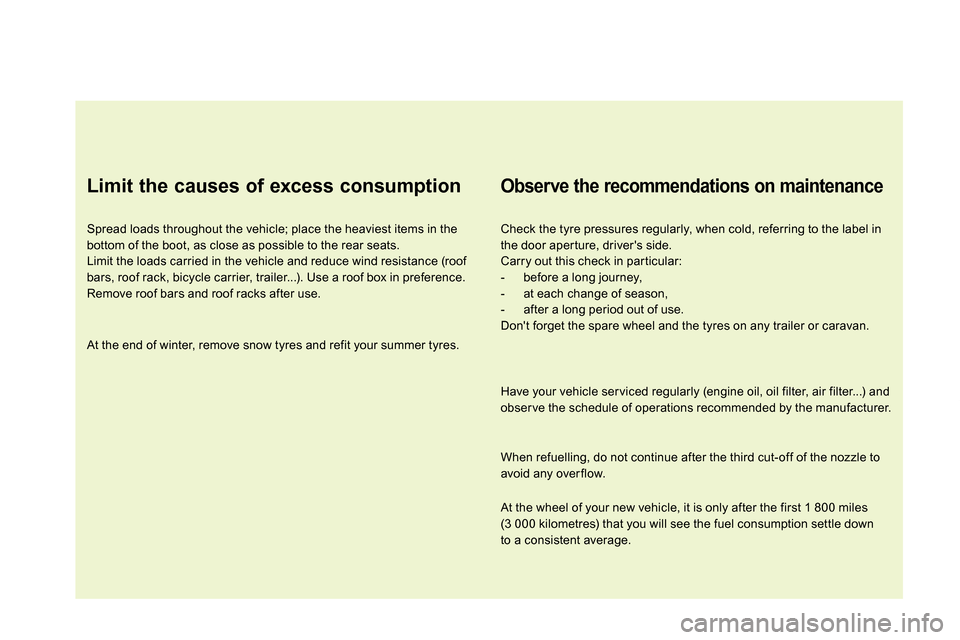
Limit the causes of excess consumption
Spread loads throughout the vehicle; place the heaviest items in the
bottom of the boot, as close as possible to the rear seats.
Limit the loads carried in the vehicle and reduce wind resistance (roof
bars, roof rack, bicycle carrier, trailer...). Use a roof box in preference.
Remove roof bars and roof racks after use.
At the end of winter, remove snow tyres and refit your summer tyres.
Observe the recommendations on maintenance
Check the tyre pressures regularly, when cold, referring to the label in
the door aperture, driver's side.
Carry out this check in particular:
- before a long journey,
- at each change of season,
- after a long period out of use.
Don't forget the spare wheel and the tyres on any trailer or caravan.
Have your vehicle ser viced regularly (engine oil, oil filter, air filter...) and
obser ve the schedule of operations recommended by the manufacturer.
When refuelling, do not continue after the third cut-off of the nozzle to
avoid any over flow.
At the wheel of your new vehicle, it is only after the first 1 800 miles
(3 000 kilometres) that you will see the fuel consumption settle down
to a consistent average.
Page 110 of 400
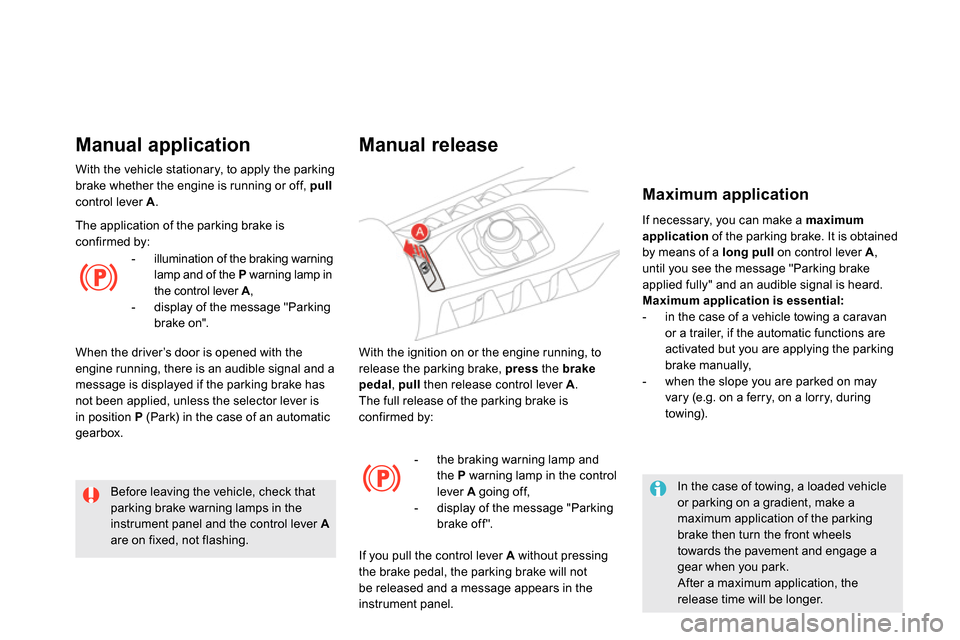
With the ignition on or the engine running, to
release the parking brake, press
the brake
pedal
, pull
then release control lever A
.
The full release of the parking brake is
confirmed by:
Manual release
- the braking warning lamp and
the P
warning lamp in the control
lever A
going off,
- display of the message "Parking
brake off ".
If you pull the control lever A
without pressing
the brake pedal, the parking brake will not
be released and a message appears in the
instrument panel.
If necessary, you can make a maximum
application
of the parking brake. It is obtained
by means of a long pull
on control lever A
,
until you see the message "Parking brake
applied fully" and an audible signal is heard.
Maximum application is essential:
- in the case of a vehicle towing a caravan
or a trailer, if the automatic functions are
activated but you are applying the parking
brake manually,
- when the slope you are parked on may
vary (e.g. on a ferry, on a lorry, during
towing).
Maximum application
In the case of towing, a loaded vehicle
or parking on a gradient, make a
maximum application of the parking
brake then turn the front wheels
towards the pavement and engage a
gear when you park.
After a maximum application, the
release time will be longer.
Before leaving the vehicle, check that
parking brake warning lamps in the
instrument panel and the control lever A
are on fixed, not flashing.
With the vehicle stationary, to apply the parking
brake whether the engine is running or off, pull
control lever A
.
Manual application
The application of the parking brake is
confirmed by:
- illumination of the braking warning
lamp and of the P
warning lamp in
the control lever A
,
- display of the message "Parking
brake on".
When the driver’s door is opened with the
engine running, there is an audible signal and a
message is displayed if the parking brake has
not been applied, unless the selector lever is
in position P
(Park) in the case of an automatic
gearbox.
Page 141 of 400
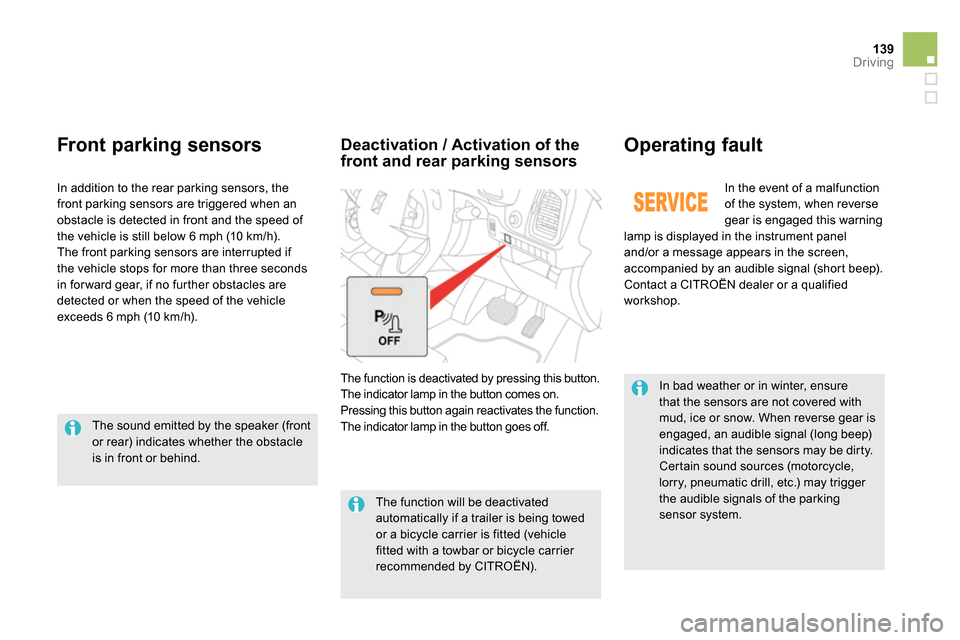
139Driving
In bad weather or in winter, ensure
that the sensors are not covered with
mud, ice or snow. When reverse gear is
engaged, an audible signal (long beep)
indicates that the sensors may be dirty.
Certain sound sources (motorcycle,
lorry, pneumatic drill, etc.) may trigger
the audible signals of the parking
sensor system.
In the event of a malfunction
of the system, when reverse
gear is engaged this warning
lamp is displayed in the instrument panel
and/or a message appears in the screen,
accompanied by an audible signal (short beep).
Contact a CITROËN dealer or a qualified
workshop.
Operating fault
In addition to the rear parking sensors, the
front parking sensors are triggered when an
obstacle is detected in front and the speed of
the vehicle is still below 6 mph (10 km/h).
The front parking sensors are interrupted if
the vehicle stops for more than three seconds
in for ward gear, if no further obstacles are
detected or when the speed of the vehicle
exceeds 6 mph (10 km/h).
Front parking sensors
The function will be deactivated
automatically if a trailer is being towed
or a bicycle carrier is fitted (vehicle
fitted with a towbar or bicycle carrier
recommended by CITROËN).
Deactivation / Activation of the
front and rear parking sensors
The function is deactivated by pressing this button.
The indicator lamp in the button comes on.
Pressing this button again reactivates the function.
The indicator lamp in the button goes off.
The sound emitted by the speaker (front
or rear) indicates whether the obstacle
is in front or behind.
Page 230 of 400
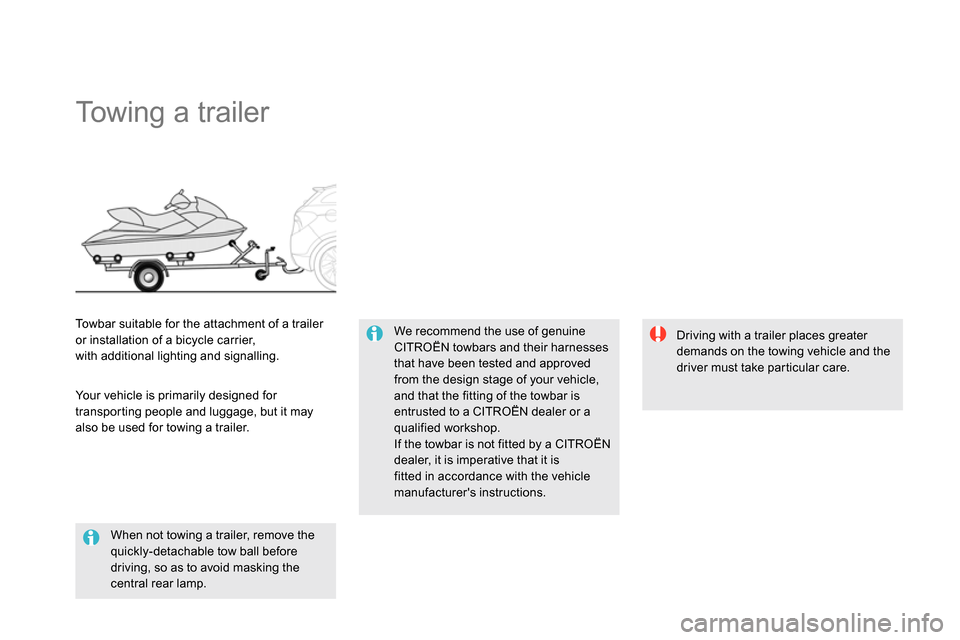
Towing a trailer
We recommend the use of genuine
CITROËN towbars and their harnesses
that have been tested and approved
from the design stage of your vehicle,
and that the fitting of the towbar is
entrusted to a CITROËN dealer or a
qualified workshop.
If the towbar is not fitted by a CITROËN
dealer, it is imperative that it is
fitted in accordance with the vehicle
manufacturer's instructions.
Towbar suitable for the attachment of a trailer
or installation of a bicycle carrier,
with additional lighting and signalling.
When not towing a trailer, remove the
quickly-detachable tow ball before
driving, so as to avoid masking the
central rear lamp.
Driving with a trailer places greater
demands on the towing vehicle and the
driver must take particular care.
Your vehicle is primarily designed for
transporting people and luggage, but it may
also be used for towing a trailer.
Page 231 of 400
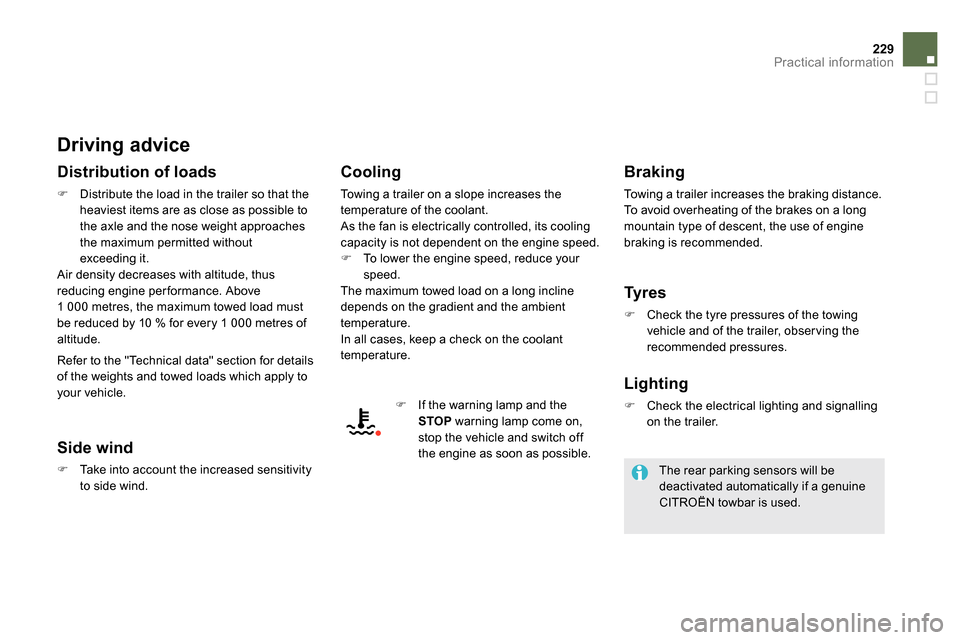
229Practical information
Driving advice
Distribution of loads
Distribute the load in the trailer so that the
heaviest items are as close as possible to
the axle and the nose weight approaches
the maximum permitted without
exceeding it.
Air density decreases with altitude, thus
reducing engine per formance. Above
1 000 metres, the maximum towed load must
be reduced by 10 % for every 1 000 metres of
altitude.
Side wind
Take into account the increased sensitivity
to side wind.
Cooling
Towing a trailer on a slope increases the
temperature of the coolant.
As the fan is electrically controlled, its cooling
capacity is not dependent on the engine speed.
To lower the engine speed, reduce your
speed.
The maximum towed load on a long incline
depends on the gradient and the ambient
temperature.
In all cases, keep a check on the coolant
temperature.
If the warning lamp and the
STOP
warning lamp come on,
stop the vehicle and switch off
the engine as soon as possible.
Braking
Towing a trailer increases the braking distance.
To avoid overheating of the brakes on a long
mountain type of descent, the use of engine
braking is recommended.
Ty r e s
Check the tyre pressures of the towing
vehicle and of the trailer, obser ving the
recommended pressures.
Lighting
Check the electrical lighting and signalling
on the trailer.
The rear parking sensors will be
deactivated automatically if a genuine
CITROËN towbar is used.
Refer to the "Technical data" section for details
of the weights and towed loads which apply to
your vehicle.
Page 253 of 400

251Te c h n i c a l d a t a
Petrol weights and towed loads (in kg)
Petrol engines
THP
1
55 hp
THP
15 0 hp
THP
160
hp
THP
200 hp
Gearbox
es
Automatic
(6-speed)
Automatic
(6-speed)
Automatic
(6-speed)
Manual
(6-speed)
Model codes
5FVA - A /1
5FEA
5FMA - Y - A /D
5FU8
- Unladen weight
1 420
1 497
1 495
1 430
- Kerb weight *
1 495
1 570
1 570
1 505
- Gross vehicle weight (GV W)
2 035
2 030
2 030
2 050
- Gross train weight (GTW)
on a 12 % gradient
3 335
2 830
2 830
2 800
- Braked trailer (within GTW limit)
on a 10 % or 12 % gradient
1 300
800
800
750
- Braked trailer ** (with load transfer within the
GTW limit)
1 500
800
800
1 050
- Unbraked trailer
74 5
74 5
74 5
750
- Recommended nose weight
75
75
75
75
*
The kerb weight is equal to the unladen weight + driver (75 kg).
**
The weight of the braked trailer can be increased, within the GTW limit, if the GV W of the towing vehicle is reduced by an equal amount; warning,
towing using a lightly loaded towing vehicle may have an adverse effect on its road holding.
The GTW and towed load values indicated are valid up to a maximum altitude of 1 000 metres; the towed load mentioned must be reduced by 10 % for
each additional 1 000 metres of altitude.
The speed of a towing vehicle must not exceed 60 mph (100 km/h) (comply with the legislation in force in your country).
High ambient temperatures may result in a reduction in the per formance of the vehicle to protect the engine; if the ambient temperature is above 37 °C,
limit the towed load.
Page 254 of 400
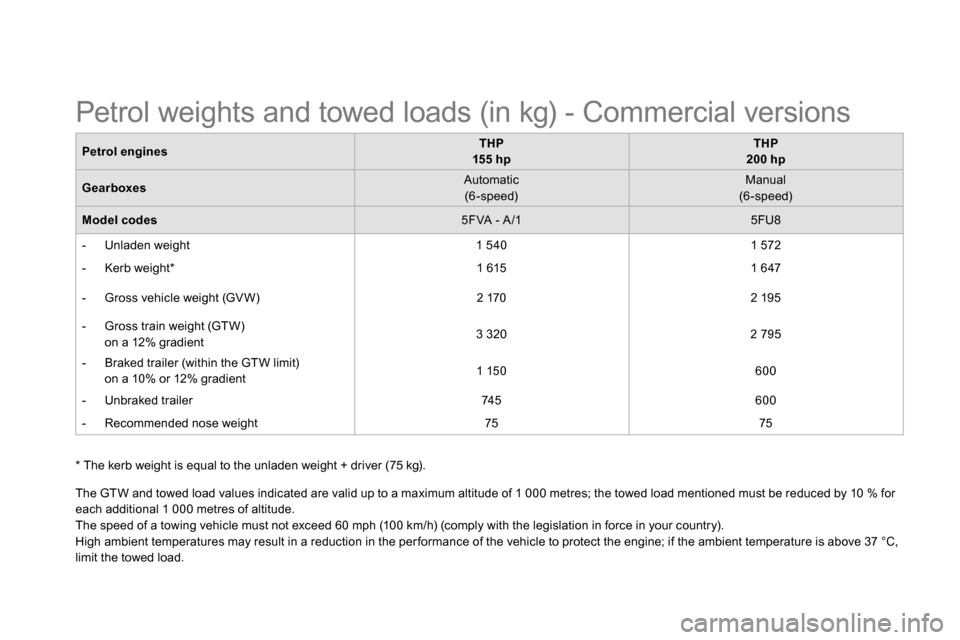
* The kerb weight is equal to the unladen weight + driver (75 kg).
Petrol engines
THP
155 hp
THP
200 hp
Gearboxes
Automatic
(6-speed)
Manual
(6-speed)
Model codes
5FVA - A /1
5FU8
- Unladen weight
1 540
1 572
- Kerb weight *
1 615
1 647
- Gross vehicle weight (GV W)
2 170
2 195
- Gross train weight (GTW)
on a 12% gradient
3 320
2 795
- Braked trailer (within the GTW limit)
on a 10% or 12% gradient
1 150
600
- Unbraked trailer
74 5
600
- Recommended nose weight
75
75
The GTW and towed load values indicated are valid up to a maximum altitude of 1 000 metres; the towed load mentioned must be reduced by 10 % for
each additional 1 000 metres of altitude.
The speed of a towing vehicle must not exceed 60 mph (100 km/h) (comply with the legislation in force in your country).
High ambient temperatures may result in a reduction in the per formance of the vehicle to protect the engine; if the ambient temperature is above 37 °C,
limit the towed load.
Petrol weights and towed loads (in kg) - Commercial versions
Page 257 of 400
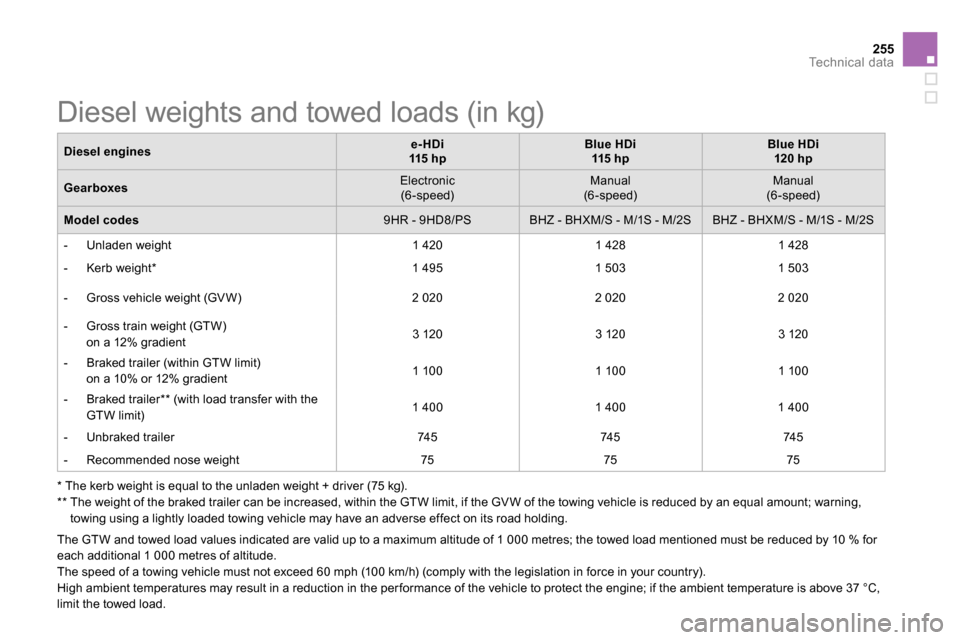
255Te c h n i c a l d a t a
The GTW and towed load values indicated are valid up to a maximum altitude of 1 000 metres; the towed load mentioned must be reduced by 10 % for
each additional 1 000 metres of altitude.
The speed of a towing vehicle must not exceed 60 mph (100 km/h) (comply with the legislation in force in your country).
High ambient temperatures may result in a reduction in the per formance of the vehicle to protect the engine; if the ambient temperature is above 37 °C,
limit the towed load.
*
The kerb weight is equal to the unladen weight + driver (75 kg).
**
The weight of the braked trailer can be increased, within the GTW limit, if the GV W of the towing vehicle is reduced by an equal amount; warning,
towing using a lightly loaded towing vehicle may have an adverse effect on its road holding.
Diesel engines
e-HDi
115 h p
Blue HDi
115 h p
Blue HDi
120 hp
Gearboxes
Electronic
(6-speed)
Manual
(6-speed)
Manual
(6-speed)
Model codes
9HR - 9HD8/PS
BHZ - BHXM/S - M/1S - M/2S
BHZ - BHXM/S - M/1S - M/2S
- Unladen weight
1 420
1 428
1 428
- Kerb weight *
1 495
1 503
1 503
- Gross vehicle weight (GV W)
2 020
2 020
2 020
- Gross train weight (GTW)
on a 12% gradient
3 120
3 120
3 120
- Braked trailer (within GTW limit)
on a 10% or 12% gradient
1 100
1 100
1 100
- Braked trailer ** (with load transfer with the
GTW limit)
1 400
1 400
1 400
- Unbraked trailer
74 5
74 5
74 5
- Recommended nose weight
75
75
75
Diesel weights and towed loads (in kg)